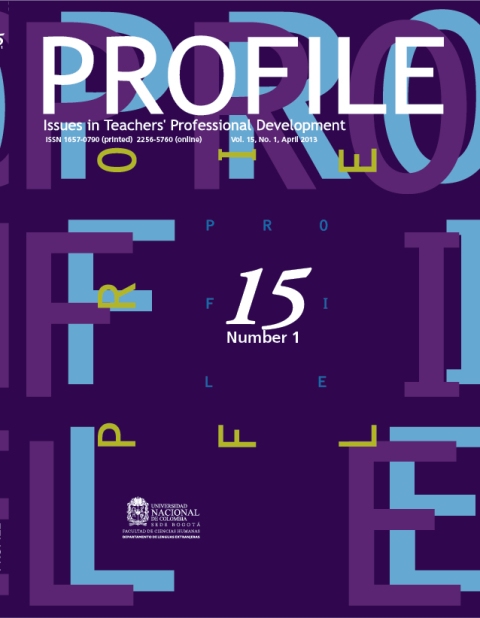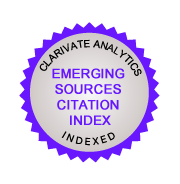Emotions as Learning Enhancers of Foreign Language Learning Motivation
Las emociones como potenciadoras de la motivación en el aprendizaje de una lengua extranjera
Keywords:
Emotional experiences, foreign language learning, motivation (en)Aprendizaje de lenguas extranjeras, experiencias emocionales, motivación (es)
The present article reports on a study that explores the effects of the emotional experiences of Mexican language learners on their motivation to learn English. In this qualitative research we present how emotions impact the motivation of university language learners in south Mexico. Results suggest that emotions, both negative and positive, contribute to enhancing and diminishing motivation. Although negative emotions may be considered detrimental to foreign language learning, the findings of this study show that negative emotions serve as learning enhancers. Results also evidence that Mexican language learners perceive negative emotions as positive for their language learning process.
En este artículo se presenta una investigación en la que se exploran los efectos que causan las experiencias emocionales en la motivación de estudiantes mexicanos al aprender inglés. Con base en un estudio cualitativo se presenta cómo las emociones inciden en la motivación de estudiantes universitarios en el sur de México. Los resultados sugieren que las emociones, tanto positivas como negativas, contribuyen a potenciar y disminuir su motivación. Se encontró que a pesar de que las emociones negativas pueden afectar el aprendizaje de una lengua extranjera, estas actúan incluso como potenciadoras del aprendizaje. Los resultados también indican que los estudiantes mexicanos perciben las emociones negativas como positivas en su proceso de aprendizaje.
Emotions as
Learning Enhancers of Foreign Language Learning Motivation
Las emociones como potenciadoras de la motivación en el aprendizaje de una lengua extranjera
Mariza G. Méndez López*
Argelia Peña Aguilar**
Universidad
de Quintana Roo, Mexico
*marizam@uqroo.mx
** argelia@uqroo.mx
This article
was received on May 5, 2012, and accepted on October 19, 2012.
The present article
reports on a study that explores the effects of the emotional experiences of
Mexican language learners on their motivation to learn English. In this
qualitative research we present how emotions impact the motivation of
university language learners in south Mexico. Results suggest that emotions,
both negative and positive, contribute to enhancing and diminishing motivation.
Although negative emotions may be considered detrimental to foreign language
learning, the findings of this study show that negative emotions serve as
learning enhancers. Results also evidence that Mexican language learners
perceive negative emotions as positive for their language learning process.
Key words: Emotional experiences, foreign language learning, motivation.
En
este artículo se presenta una investigación en la que se exploran
los efectos que causan las experiencias emocionales en la motivación de
estudiantes mexicanos al aprender inglés. Con base en un estudio
cualitativo se presenta cómo las emociones inciden en la
motivación de estudiantes universitarios en el sur de México. Los
resultados sugieren que las emociones, tanto positivas como negativas,
contribuyen a potenciar y disminuir su motivación. Se encontró
que a pesar de que las emociones negativas pueden afectar el aprendizaje de una
lengua extranjera, estas actúan incluso como potenciadoras del
aprendizaje. Los resultados también indican que los estudiantes
mexicanos perciben las emociones negativas como positivas en su proceso de
aprendizaje.
Palabras clave: aprendizaje de lenguas extranjeras, experiencias emocionales, motivación.
Introduction
From the first
motivational studies, affective aspects have been considered to be as important
as language aptitude in language learning success (Gardner & Lambert, 1972;
Gardner, 1985). However, no consideration was given to these until humanistic
education brought attention to the affective domain. Affective factors research
in foreign language learning has concentrated on constructs such as self-esteem
and learners’ beliefs (Aragão, 2011). Although this research has
advanced our knowledge of these factors, emotions have not yet been given enough
attention in foreign language learning research (Imai, 2010).
Although the
introduction of the humanistic methods e.g. The Silent Way, Community Language
Learning and Suggestopedia acknowledged the important role of affect in
language learning, some scholars did not consider this approach beneficial for
language learning. While some authors favoured the use of affective strategies
or humanistic activities in language classes (Arnold, 1998; Arnold & Brown,
1999), others state that English language teaching (ELT) teachers should be
more concerned with the language they are supposed to help students learn
(Gadd, 1998).
Currently,
researchers recognize the need to review motivation from an affective
perspective (MacIntyre, 2002; Dörnyei, 2005, 2007; Meyer & Turner,
2006). Nevertheless, motivation research in foreign language learning has
largely focused on studying it as if motivation were a stable, non-dynamic
construct which is not developed through interaction with teachers, peers,
subject content and context (Dörnyei, 2000; Larsen-Freeman, 2001; Ellis,
2004; Shoaib & Dörnyei, 2004). Some studies have concentrated on
establishing correlations between motivation and language proficiency (Ellis
& Larsen-Freeman, 2006), while other studies have focused on identifying
and analysing diverse motives and validating motivational theories, instead of
concentrating on the development of motivational strategies than can help
students to cope with the process of learning a foreign language (Cheng &
Dörnyei, 2007). Consequently, motivation has largely been researched
within a quantitative approach which has provided diverse results in the field
of English language teaching.
Although some
studies have been done on emotions in ELT (Hurd, 2008, Garret & Young,
2009; Bown & White, 2010; Imai, 2010, Aragão, 2011), they have not
concentrated on the connection of these to the motivational behaviour displayed
by foreign language learners. Due to this situation, our research question was:
What effects do emotional experiences have on foreign language learners’
motivation? Thus, this study aims to contribute to the body of knowledge on how
foreign language learning motivation is shaped by emotions.
Origin of this Research Project
Our research
interest was based on a piece of research one of the researchers had undertaken
(Méndez, 2003). In this previous study, affective strategies were found
to be amongst those least used by students. This was surprising for us since
the study was carried out in Mexico, which is a collectivist society (Hofstede,
2010). Mexicans in general are people who make use of social and affective
skills in all areas of their lives. Why, then, were Mexican students not making
use of affective strategies?
Current motivation
literature states the need to start researching foreign language learning
motivation from an affective perspective (MacIntyre, 2002; Dörnyei, 2005,
2007; Meyer & Turner, 2006). The new direction scholars suggest regarding
motivation research matched with our interest in affective strategies by combining
these with motivation, which is considered to be a factor that can make a
student succeed or not succeed in their language learning process. Therefore,
our study focused on the role played by the emotional experiences foreign
language learners undergo during classroom instruction, and how these impact
their motivation.
Overview of Motivation and Emotions Studies
In order to understand the role of emotions in
language learning motivation, we focused on two theoretical constructs:
motivation and emotions.
Motivation
The motivation
construct is a very complex one that cannot be analysed from an isolated angle
(Dörnyei, 2001). Different motivational approaches have been developed in
order to try to understand this multifaceted construct. Four motivational psychology
theories have been selected as those informing the interpretation of this
study’s results: self-efficacy theory (Bandura, 1997), attribution theory
(Weiner, 1992), self-worth theory (Covington, 1998) and self-determination
theory (Deci & Ryan, 1985).
According to
Bandura (1994), self-efficacy refers to “(...) people’s beliefs
about their capabilities to produce designated levels of performance that
exercise influence over events that affect their lives” (p. 71). These
beliefs are the ones that shape how people feel, think, motivate themselves and
behave. According to this theory, people with a high level of self-efficacy
engage in tasks with the conviction that they possess the capabilities needed
to succeed in them. In contrast, a person with a low level of self-efficacy
avoids difficult tasks and resorts to their personal weaknesses to justify
their lack of effort to pursue certain goals.
Self-efficacy
beliefs affect human activity cognitively, affectively, motivationally and
socially. People tend to plan what to do and how to achieve their goals, so
this planning is shaped by the beliefs people have about their abilities to
achieve such goals. Self-efficacy beliefs influence people affectively because,
as a result of their ability assessment, some people are more prone to
suffering from depression when involved in a challenging or threatening
situation. However, positive self-efficacy feelings can encourage people to
continue making their best effort in order to achieve specific goals. Thus, a
person’s life course is determined by the abilities they believe they
possess.
Attribution theory
assumes that human motivation is a result of the need to know the reason why
something has happened. Thus, causal attributions of a phenomenon can be given
to a person or to environmental factors. If a student, for example, has had
very bad learning experiences which he or she attributes to his or her
capacities, he or she might not be willing to participate in any learning
activity again because he or she considers that the cause of failure is
something he or she cannot change (his or her cognitive ability); however, if a
learner considers that the reason for failure is that he or she did not make
his or her best effort, then he or she could go into a new learning situation
with the disposition to make his or her best effort so he or she can have
better results this time. According to the most well-known
scholar Weiner (1980), “The most salient causal inferences are ability
and effort, but many other factors are also influential” (p. 393).
According to
Covington (1992), self-worth theory “(...) assumes that the search for
self-acceptance is the highest human priority, and that in schools
self-acceptance comes to depend on one’s ability to achieve
competitively” (p. 74). Thus, in schools learners are considered as
worthy as their abilities to achieve educational goals imposed by schools and
teachers. As such, a student’s value is measured only through school
achievement. This being the case, in school achievement, the focus of student
life, different actions are performed by students in order to protect their
self-image. Ability equals worth in schools, and it is this premise that makes
students develop strategies such as over striving or cheating to protect
themselves from negative appraisal of their ability by their peers.
According to Ryan
and Deci (2000), self-determination theory focuses on “(...)
investigating people’s inherent growth tendencies and innate
psychological needs that are the basis for their selfmotivation and personality
integration” (p. 68). They consider that the construct of motivation lies
in a continuum of self-determination that goes from amotivation (lack of
motivation) through external, introjected, identified and integrated regulation
(externally regulated) to intrinsic motivation (intrinsically regulated). Ryan
and Deci’s (2000) final type of motivation on the continuum, intrinsic
motivation, is “(...) the inherent tendency to seek out
novelty and challenges, to extend and exercise one’s capacities, to
explore, and to learn” (p. 70). In order for this type of innate
motivation to be maintained, Ryan and Deci identify three conditions that need
to be present: competence, relatedness and autonomy. Thus, it is not only that
people need to feel competent in the different actions they perform throughout
their lifetime, but they also need to feel that these actions are
self-initiated in a supportive environment. Relatedness refers to the need
people have to be accepted, respected and connected to significant others in
their social environment. According to the abovementioned authors, the social
environment in which people grow is a crucial determinant of the enhancement or
diminishment of intrinsic motivation.
Motivation is
powerfully influenced not only by learners’ personalities but also by
personal experiences, cognitive processes and the social context.
Learners’ behaviour is determined by the need to protect their self-image
and to preserve their self-worth, and is influenced by significant others and
the socio-cultural context in which they live. Thus, motivation is powerfully
influenced not only by learners’ personalities but also by personal
experiences, cognitive processes and the social context. All of these factors
imply an array of emotions and feelings aroused in intra- and interpersonal
interactions. A complex interaction of numerous student and situational
characteristics determines foreign language learners’ motivation. Given
that language learning is a socially constructed process, the diversity of
emotions experienced is a crucial aspect impacting on the motivational
behaviour displayed by foreign language learners.
Emotions
Feelings and
emotions experienced by students are considered important in understanding
learning processes, student motivation and effective teaching (Pekrun, Goetz,
Titz & Perry, 2002; Meyer & Turner, 2006). Feelings and emotions are
said to be a result of the evaluation students make of particular situations
while learning (Pekrun, 2000). These evaluations are influenced by previous
experiences, the social context and their personal goals (Pekrun et al., 2002;
Sansone & Thoman, 2005). This is of particular relevance to the learning of
a foreign language since students mostly come with previous positive or
negative experiences; sometimes the new learning environment is very different
from previous ones, and they may have a diversity of motives for engaging in
foreign language learning. The interplay of all these variables in one
emotional event during classroom instruction may have different meanings for
individual students and cause diverse effects on students’ motivation (Do
& Schallert, 2004). The resulting tasks learners decide to carry out
account for the amount of motivational energy variation language learners go
through during the different stages of their learning process (Shoaib &
Dörnyei, 2004). Emotional experiences play a significant role since behind
the reasons for deciding to study a foreign language or keep up with the task,
emotions and feelings are involved. Those feelings and emotions experienced
during foreign language learning/instruction are then important to understand
so language teachers can adjust their approach to one that can help them reduce
the negative impact emotions can have on learners’ motivational energy,
and enhance the promotion of those emotions that can activate learners’
motivation.
Pekrun et al.
(2002) found that anxiety was the emotion most frequently reported in five
studies conducted using quantitative and qualitative approaches. However, these
studies reveal that students reported as many positive emotions as negative
ones; thus the array of emotions students go through during learning is vast. A
significant outcome of Pekrun et al.’s studies is the discovery of the
role played by meta-emotions (feelings about emotions) on the management of
emotions. Pekrun et al. suggest that making learners aware of their feelings
about their emotions may be a tool teachers should use to help students face
and overcome negative emotions as well as foster positive ones.
According to
Scherer (2005), feelings and emotions prepare people to act; this implies that
if someone is acting in certain ways, the experience of a feeling or emotion
can make him or her stop that particular action (changing their motivational
energy) or continue making the best effort possible to achieve a particular
goal. Thus, the change in motivational energy can be positive or negative; it
depends on the interplay of emotions with internal and external factors. In
addition, feelings and emotions can help someone to redirect their motivational
energy. In the course of academic work, students can find that something
strongly interests them and redirect all their attention and motivation toward
that particular task.
Garret and Young
(2009) explored the emotional reactions originated during a Portuguese as a
foreign language course for a period of eight weeks. Although their study was
not focused on accounting for emotions, emotions became the core of the
description provided by Garret’s responses to instruction, revealing the
significant role emotions play in language learning processes. Garret and Young
(2009) described 255 positive emotional experiences and 69 negative ones.
Positive and negative experiences were mainly engendered because of the
teachers’ voices, social relations, cultural learning and language
awareness.
Imai (2010)
investigated the manifestation of emotions during group-work preparation for a
second language oral presentation. He found that during task preparation
language learners’ mental processes were structured through the
verbalisation of their emotions, which then developed into common group
feelings. Thus, emotions felt by the three members of the group served to
construct the same feelings towards the activity through negotiation of their
reactions to the learning task they were carrying out. From this, Imai (2010)
concludes that even negative emotions can be a developmental resource for
foreign language learners.
Although conducted
under a self-regulatory framework, the study carried out by Bown and White
(2010) also reflects the emotional experiences learners in classrooms go
through. In the individual reflections of three learners, the interaction of
their previous language learning experiences, current learning events and goals
played a significant role in their motivational behaviour. In this
self-regulated framework where instances of face-to-face interaction were
minimal and requested by learners, the facilitator’s gestures and verbal
feedback caused such negative emotions in one student that she withdrew from
the course. These result showed how even the scarce contact with instructors
initiated by learners in this learning context evoked such negative emotions
that their motivation was impacted. These students’ emotions in
face-to-face interaction with instructors were evoked because of the
instructors’ body language, non-verbal expressions and feedback provided.
Thus, the significant effect of instructors in the ELT field was displayed even
in autonomous language learning experiences, which confirms that the
development of positive interpersonal relations in language learning processes
is a core aspect of instilling motivation and effective ELT.
Research Design
This study followed
a qualitative approach since our purpose was to gain a deep understanding of
the emotional reactions engendered during foreign language classroom
instruction. The purpose of qualitative research is to examine any social phenomenon
by enabling the researcher to go into the participants’ naturalistic
setting and try to get a comprehensive understanding of it (Bryman, 2004). In
the following section we will present the participants, the techniques and the
data analysis process.
Participants of the Study
This study was
carried out in a public university in south Mexico. A group of 24 students who
were starting their second year of the ELT programme was best suited for the
purpose of the investigation. The group selected was chosen because the teacher
in charge of the language class agreed to give us access; thus, convenience
sampling was exercised (Bryman, 2004). Purposeful sampling was employed and the
sample was small because the intention was to obtain rich information about students’
emotional experiences in classroom language instruction and the effect of those
on motivation. As stated by Mertens (1998), “In
interpretive/constructivist work, samples tend to be relatively small because
of the depth of information that is sought from each case or individual”
(p. 264). Although researchers of the study are part of the ELT programme
staff, the main researcher was not teaching during the study period.
Participation was voluntary and 18 students agreed to share their emotional
experiences during classroom language instruction. Students were informed about
the purpose and activities involved in this investigation. Consent forms were
given to the participants who used a pseudonym while participating in the
study. No intervention on participants’ classes was made since, as Do and
Schallert (2004) advise, “Studies are needed that focus on emotions and
moods embedded in a real context rather than induced and separated out for
investigation” (p. 620).
Methods of Data Collection
Qualitative methods
allow the gaining of a deep understanding of the motives behind human behaviour
(Barbour, 2008). Data were gathered through personal narratives, an emotional
reactions journal and semi-structured interviews. Participants completed these
three techniques using their native language / their mother tongue because we
did not want to restrict their emotional descriptions. Personal narratives were
selected as the instrument to find out about the development of students’
motivation to register in the ELT programme. Personal narratives were written
at the beginning of the study period. According to Oxford (1995), “The
technique of writing language learning histories gives learners the opportunity
to describe their own language learner experiences and express their feelings
about those experiences” (p. 581). Since this study is focused on
students’ feelings, we felt that this instrument would be best suited to
finding out not only the origin of the students’ motivation but also of
the feelings experienced during those specific moments when motivation
developed. One of the main advantages of personal narratives is that they give
us access into learners’ private worlds and provide rich data (Pavlenko,
2002, 2007). Since emotions are not always observable, the best way to get into
people’s feelings and emotions is to let them narrate them to us.
Interviews were
identified as a suitable source of data to explore students’ affective
experiences. According to Yan and Horwitz (2008), “(...) studies that
encourage learner reflection through interviews (…) would seem to have
the potential to yield a richer understanding of learners’ perceptions
(…)” (p. 153). A semi-structured interview guide was designed to be
used as a general guide so that some issues that were not considered by the
researcher but that participants considered important could be addressed in the
interview. 18 interviews were recorded, transcribed and then analysed at the
end of the term (see Appendix).
In this study, the
journals were focused on those events students experienced during classroom
instruction that triggered in them an emotional reaction. Students were asked
to keep a journal over 12 weeks of their term. Students were free to report
about any emotion felt in their journal entries which were sent electronically
weekly.
According to
Hascher (2008), students’ journals “(…) are a useful
qualitative approach to explore students’ emotions (…) they offer a
precise view on an individual’s perspective and they enable a context-sensitive
understanding of emotions in schools” (p. 95).
Data Analysis
The study followed
a Grounded Theory approach for data analysis (Glaser & Strauss, 1967),
which consists of a set of data collection and analytic procedures through
which the researcher derives an abstract theory of a process, action or
interaction of a particular phenomenon (Charmaz, 2004; Creswell, 2009). The
data analysis was divided into four stages. In the first stage personal
narratives were read to understand the motivational events that led students to
register in the ELT programme. In the second stage students’ emotional
journal entries were read over the 12 week period in order to identify the
emotions experienced by students during classroom instruction. Then, the journal
entries were collapsed into three sets and imported to Nvivo 8 software to aide
analysis of the study period (weeks 1-4; weeks 5-8; weeks 9-12). Stage three
included the transcription and analysis of the interviews. This stage allowed
us to verify that some patterns identified in journals were also present in the
final interviews. The final stage included the analysis of journal sets and
interviews in Nvivo 8 software. Units of text were grouped together in analytic
categories and were given a title. Data were systematically reviewed to ensure
that references under analytic categories supported these categories.
Participants of this study were asked to confirm that the conclusions we drew
from the information provided by them corresponded to the world they wanted to
present to us. Participants were also asked to check transcripts of the
interviews and edit their content if desired. Although some participants did
edit or add to the final interviews used for analysis, most students left them
as transcribed.
Based upon the above description of the data analysis,
the emerging themes are presented in the following section.
Findings
The categories that
emerged from our data analysis are presented in four sections: positive effects
of positive emotions, negative effects of positive emotions, negative effects
of negative emotions and positive effects of negative emotions (see Table 1). This last one is presented with its corresponding
subcategories: language learning awareness, language learning strategies and
developing motivational strategies. These three perspectives are aimed at
presenting a richer and more complete picture of the diversity of responses
found in Mexican students’ emotional experiences. The data were
translated into English for the purpose of this publication. Real names of
participants have been changed throughout the whole article.

Effects of Emotional Experiences on Language
Learners’ Motivation
All (18) students
considered that emotions, both positive and negative, were of great importance
for their language learning process because emotions encouraged them not to
quit their language classes and gave them the drive to overcome those academic
problems they were facing, as they reported:
(...) emotions are of great importance, without them I would have been a mediocre student...leaving everything half-assed, and thanks to them I am still at university. I consider that there are not good or bad emotions ... good as well as bad ones ended up being good because without the bad ones I would not have had the push to make my best effort at university. (Enrique, Interview)
As revealed by all
(18) students in the study, emotions were positive because they helped them
think about their role as language learners, made them realize those areas they
needed to work on and, most importantly, made them reflect upon their
responsibility as language learners.
Positive
Effects of Positive Emotions
Students
experienced positive emotions that allowed them to have feelings of enhanced
self-efficacy. These feelings allowed them to attest their language
advancement, which contributed to removing their insecurity and giving them
confidence, as expressed by some students:
...for instance when teachers told me something good about my performance in class, I felt really happy ... I was so enthusiastic all day in classes. You feel great ... you feel like participating more in class because you know you are doing things right. (Akira, Interview)
As the term
advanced, students felt more confident because they were able to see that their
efforts were paying off, especially in examination marks, which are very
valuable for Mexican students:
Happiness because I saw the results ... I could confirm that if I worked hard I could have good results ... this is what makes ... this is what makes me feel happy ... knowing that yes, I can! (Kenya, Interview)
Confidence allowed
students to take some risks in their language learning process and some started
to refer to mistakes as something that they have to go through in order to be
able to speak a foreign language. Students also started looking for ways to
introduce phrases or vocabulary they had heard on TV shows in English (USA TV)
in order to make their oral and written output more natural. These small
decisions allowed them to reenergise and helped them to keep motivated.
Negative
Effects of Positive Emotions
Students
experienced feelings of self-efficacy after completing tasks successfully.
Nonetheless, 16 of them recognised that after a positive emotion they did
nothing to improve their language learning process:
Well ... a negative emotion leads you to analysis … happiness … um, there is nothing to analyse there because you are happy as you obtained what you wanted, but negative experiences are the ones we need to think about, reflect on and look for the positive side of. You have to look for that positive side in order to be more proactive or a winner, we can say in that respect. (Jimmy, Interview)
Students reported
that after a positive emotion there was nothing to do but enjoy the feeling, so
they did not think about it. This is the only negative effect positive emotions
had on students’ motivation.
Negative
Effects of Negative Emotions
Negative emotions
were frequently experienced by this group of students. There were different
factors that triggered negative emotions such as: teachers’ marking
systems, feedback approaches and learning environment. For the first time
students were facing being spoken to in English for the whole class period, and
doubts about their degree choice started to emerge from the very first week of
the term. Half of the students (nine) revealed in their personal narratives
having wanted to study something different but, because of financial reasons,
they had had to choose a degree at the local university. This fact made them
doubtful about being in the ELT programme.
Having obtained such a low mark made me feel really bad and has made me think about the English language teaching programme being the right degree for me. (Jane, Journal. Weeks 1-4)
Feeling unsure of
being able to finish the degree caused insecurity in students, which
contributed to their fears. Students’ fears led some (nine) to see
English learning as a very difficult task that they were not able to
accomplish.
If I was feeling confident, OK about my development in class– this week made me feel really down. This was because of a writing task...we all felt that our work was not perfect but good. However, I realised it wasn’t. It was completely frustrating (…) I wonder if I will be able to learn English someday! (Jaded-Journal. Weeks 1-4)
This perception was
magnified by the presence of an advanced group of students in class. By looking
at this group’s performance, students realised the great gap between them
and the advanced group. Students’ confidence deteriorated because they
started to make comparisons with more proficient learners in the group. The
language proficiency difference contributed to a lack of group cohesion, which
made the learning environment very ineffective:
I had an oral presentation and I thought, ‘I don’t want that guy to come’. I feel intimidated when he is in the class because I think he is going to say something … someone told me he criticises and makes fun of the rest of the class … so I now feel frightened even in oral exams because I don’t want to take it with him because besides being beaten by him he is going to make fun of me and that is my fear. (Esperanza, Interview)
Lack of group
cohesion contributed to students’ feelings that they were not allowed
space and time to practise. This feeling led them to think they were not making
any progress and perceived their pronunciation to be not as good as that of
their classmates. This constrained their participation in class because they
knew that some classmates would mock them. Fearing the teacher’s feedback
and their peers’ mockery led students to stop trying in class. This made
some students feel angry with themselves but they
reported that sometimes their fear of mockery was higher than their desire to
speak fluently.
Although students
reported that being afraid of speaking English and having a fear of their
peers’ mocking were constant feelings throughout the term, they also
revealed, importantly, that the effects of these events were short-lived
because they could not spend all the time recalling a specific negative event.
Positive
Effects of Negative Emotions
It seems
contradictory that, although some (nine) students reported not having chosen
the ELT programme at the university as their first choice, they were struggling
hard in order to continue in the course in spite of their constant negative
experiences. However, from the perspective of self-determination theory,
Mexican participants may have internalised as their own the demands of their
parents and relatives to whom they feel a very strong attachment. As suggested
by Bao and Lam (2008), “People from collectivistic cultures may still be
motivated when they act on the demands of in-group others because they can
internalize such demands” (p. 270).
Negative emotions
started to emerge during the first sessions of the course. Students’
knowledge was very basic and they started to panic when unable to understand everything
the teacher was saying or explaining. Fear, worry and sadness were the three
main negative emotions students experienced during the first third of the term.
Students reported being afraid of being laughed at while participating in class
activities, worried about not being able to understand everything the teachers
were explaining, and sad about their lack of vocabulary which restricted their
participation in class. The language proficiency difference in the group pushed
low proficient learners to develop their language abilities. It was because of
this that students started to develop a sense of responsibility towards their
language learning process, which led them to develop learning and motivational
strategies from the very first week of the term:
Well …I asked a student from the last semester to help me review my pronunciation for the oral exam. (Esperanza, Journal. Weeks 5-8)
I have to think that I am at a learning stage … I do not have to ask myself what I cannot do at this stage … I have to work on this. (Angelica, Journal. Weeks 1-4)
Language Learning
Awareness
Students’
constant comparisons with their proficient peers not only made them feel sad
and frightened, it also made them aware of the time and effort needed to be
able to speak fluently:
Well … I have tried to do certain things so I can feel good about myself and do not feel sad or down because I see the advanced students. If they are more proficient it is because they have studied more and I do not have to feel bad about it. On the contrary, I have to make my best effort in my studies. (Natalia, Interview) Thanks to all these experiences in class I am more conscious of the need to invest more time to study at home … I have been looking for web pages to practise and chat with native speakers so I can learn expressions and be able to speak better. (Ricardo, Journal. Weeks 1-4)
Students embraced
negative emotions as learning opportunities because all of them (18) referred
to these negative events in class as a way of understanding what they were
doing wrong and how to improve on that particular skill. Most students’
(17) fear focused on their speaking ability because it was the skill that
caused their peers to make fun of them. Students started to look for vocabulary
to enrich their oral participation, practised their vocabulary by watching TV
shows in English (USA TV programmes), encouraged peers to practise with them in
order to gain confidence, and dedicated more time to reviewing the topics
covered in class at home.
I analysed myself and realised that I have to practise my English every day … I registered in a conversation workshop and started to review every night the notes from my class. (Jimmy, Journal. Weeks 1-4)
Most students (16)
reported recognising areas in which they were making mistakes, while others
started to develop resilience towards negative experiences. Some students (ten)
stated that these negative experiences were things they needed to overcome if
they wanted not only to pass the course, but also to finish the degree.
Students considered these negative experiences as a natural process that needed
to be faced if they desired to speak a foreign language. This is clearly
expressed in the following references:
When participating in class and making some minor errors, I realised there is nothing wrong with making them … we all have to go through that … and by not taking the mockery or offensive criticisms into account … I think this is the best I have done to feel motivated to make my best effort in the future. (Jaded, Journal. Weeks 1-4)
I think in a negative way but thinking carefully…positive because every time I am at the front saying something or explaining something … speaking in public helps me to overcome this weakness that I need to be a strength in the future… (Jane–Journal. Weeks 9-12)
Although some
(nine) students felt insecure about their abilities to learn a foreign language
during the first third of the term, most of them (16) convinced themselves that
it was a matter of practice and not a lack of intellectual ability (Covington,
1992). This contributed to students looking for solutions to improve their
language knowledge by making use of different learning strategies that could
help them to learn in more easily.
Language Learning
Strategies
From experiencing
the very first negative emotions in class, students started to look for ways to
make their language learning process an effective one. Students resorted to the
use of learning strategies to diversify their approach to learning English.
Students reported making use of diverse strategies in order to overcome those
learning difficulties they were facing in their daily classes. Some (eight)
students reported not feeling upset about the language proficiency of the
advanced students but motivated to be able to speak like them in the future.
The group of proficient students helped beginner students to develop resilience
towards negative feelings experienced by their language level difference and
encourage less proficient students to make their best efforts, as reported by
the different ways they used to approach their learning concerns:
I don’t have to feel worthless in class just because others participate or understand better than me. I have to make my best effort to be at their level. (Natalia, Journal. Weeks 1-4) I started to listen to conversations in English, to watch movies to practise my vocabulary and pronunciation … and I am also listening to songs in English. (Dayana, Journal. Weeks 1-4)
Language learning
strategies were tools students made use of in order to develop their language
abilities and their confidence in class. As their ultimate goal was to get a
university degree and move on to employment in order to fulfil other needs in
their lives, students also resorted to the use of motivational strategies to
keep them stimulated to continue in the ELT programme and finish it.
Developing
Motivational Strategies
All (18) students
agreed that maintaining their motivation was their own responsibility. However,
they also considered that teachers could contribute greatly to it by making
classes more dynamic and learning activities more fun. Students also recognised
that their families were a part of this responsibility. They considered that
they needed that affective push from mothers, fathers, siblings and friends to
re-energise. Students reflected on their family values when referring to being
motivated. Most students (16) resorted to emotional self-regulation and self-encouragement
in order to keep their motivation energy at good levels:
Believe in myself … believe that I can achieve my goal of learning English and finishing the degree if I desire … I have to set some goals and complete certain activities that I have planned to learn more every day … believe that I can do it. (Kenya, Journal. Weeks 9-12) Every day when I arrive at class I repeat to myself that everything is going to be all right and I believe it. (Ricardo, Journal. Weeks 5-8)
Students seemed to
have developed resilience towards negative emotions. All students referred to
the experience of negative feelings as positive for their language learning
process. They all recognised that during their future life they would have to
face many negative events so they had to be prepared to face them.
Conclusions
Emotional
experiences were identified as having a significant role in Mexican
students’ motivational behaviour during classroom instruction.
Educational scholars have affirmed that emotions play a significant role in
motivation to learn (Garret & Young, 2009; Bown & White, 2010; Imai,
2010). In fact, participants in this study reported that attention to affect
was the difference in the motivational behaviour they displayed in their
language classes.
Emotional
experiences had a significant influence on students’ motivation.
Emotions, both positive and negative, have an important impact on foreign
language learners’ motivation, since they can activate or deactivate
motivational behaviour (Pekrun et al., 2002). Experiencing both types of emotions
was considered significant for students’ language learning process since
they helped them to regulate learning, as well as to regulate emotions.
Motivation was revealed as dynamic and evolving. Diverse emotional influences
impacted the motivational behaviour of this study’s participants.
Although students experienced more negative situations than positive ones, they
turned these into positive outcomes. The predominance of negative activating
emotions (fear, worry and sadness) in this study might have triggered
students’ motivational behaviour to overcome those negative emotions in
future academic tasks, and this might explain their motivation maintenance.
The frequent and
sometimes intense negative emotions reported to be felt by participants in our
study were not enough to diminish their overall motivation, since all the
participants revealed themselves to be highly motivated to finish the ELT
programme (Ryan & Deci, 2000). Negative emotions had the negative effect of
causing demotivating behaviour in some students. However, students revealed
that negative emotions led them to reflect on the situation experienced, which
allowed them to re-evaluate the event and adjust their motivation accordingly.
The reflection process described by participants included an attribution stage
in which learners gave themselves an explanation of why the event resulted in
that emotion (Weiner, 1992).
Participants of
this study realised that although there were many factors influencing the way
they reacted to emotional experiences, they could only change similar events in
the future by improving their language level. As students attributed these
negative feelings to their language proficiency, they immediately resorted to
the use of learning strategies that helped them face negative emotions and kept
them motivated. We believe this realisation during the reflection process is
the one that led students to focus on those areas they needed to improve upon
in order to enhance their language learning process. Thus, although negative
emotions had an immediate negative effect on students’ motivational
energy, causing such behaviour as task avoidance and withdrawal from class
participation, subsequent reflection allowed students to overcome that negative
impact and to reenergise in order to continue their learning process.
Motivation in
language learning cannot be developed in a vacuum; certain conditions need to
be present before motivation can be initiated. Language learning is a process
replete with negative and positive emotions, thus appropriate management of
students’ emotions is necessary for language teachers to enable them to
help their students make their emotions work for them and not against them. The
creation of a positive learning environment should therefore be the first aim
language teachers strive for. This can be created through promoting group
cohesion and establishing good teacher-student relationships. By showing
genuine interest in students’ learning processes, teachers will inspire
trust, confidence and a motivating learning environment.
Reflection should
also be encouraged so learners can understand their emotions better as
learners, and this can help students set individualised goals to work toward. A
peer-support scheme could be set up so students have a space to talk about
their learning worries, and where feelings of affiliation can be promoted.
Self-evaluation should be encouraged on a weekly or monthly basis so students
can review the strategies they are using, the success—or lack of success—they
are having with them, and can set new objectives to work towards.
More research needs
to be carried out in diverse contexts in order to find out what outcomes are
derived from negative emotions and how specific contexts modify their impact on
motivation. Future research also needs to make a comparison of the emotional
experiences encountered by lower-level and proficient learners. Do students at
different levels react differently to the same emotional experiences?
This research has
uncovered a range of context governed factors affecting language learning
motivation. It also provides evidence for understanding the developmental
process of motivation and how language learners become responsible thanks to
the reflection on emotional experiences during language instruction. We hope
that the results presented can assist in the understanding of emotions
experienced by language learners during classroom instruction and inform the
design of interventions and activities to help language learners manage
negative emotions.
References
Aragão, R. (2011). Beliefs
and emotions in foreign language learning. System, 39(3),
302-313.
Arnold, J. (1998). Towards more
humanistic language teaching. ELT Journal, 53(3), 235-242.
Arnold, J., & Brown, D. H. (1999). A map of the terrain. In J. Arnold (Ed.), Affect in language learning (pp. 1-24).
Cambridge, UK: Cambridge University Press.
Bandura, A. (1994). Self-efficacy.
In V. S. Ramachaudran (Ed.), Encyclopedia of human
behavior (pp. 71-81). New York, NY: Academic Press.
Bandura, A. (1997). Self-efficacy: The exercise of
control. New York, NY: Freeman and Company.
Bao, X. H., & Lam, S. F. (2008). Who makes the choice? Rethinking
the role of autonomy and relatedness in Chinese children’s motivation.
Child Development, 79(2), 269-283.
Barbour, R. (2008). Introducing
qualitative research: A student guide to the craft of doing qualitative
research. London, UK: Sage.
Bown, J., & White, C. J. (2010). Affect in a self-regulatory framework for language
learning. System, 38(3), 432-443.
Bryman, A. (2004). Social research methods (2nd
ed.). Oxford, UK: Oxford University Press.
Charmaz, K. (2004). Grounded theory.
In S. Hesse-Biber, & P. Leavy (Eds.), Approaches to qualitative
research: A reader on theory and practice (pp. 496-521). New York, NY:
Oxford University Press.
Cheng, H. F., & Dörnyei, Z. (2007). The use of motivational strategies in language
instruction: The case of EFL teaching in Taiwan. Innovation in Language
Learning and Teaching, 1(1), 153-174.
Covington, M. V. (1992). Making the
grade: A self-worth perspective on motivation and school reform. Cambridge,
UK: Cambridge University Press.
Covington, M. V. (1998). The will to learn: A guide
for motivating young people. Cambridge, UK: Cambridge University Press.
Creswell, J. W. (2009). Research design:
Quantitative, qualitative, and mixed methods approach. Thousand Oaks, CA:
Sage.
Deci, E. L., & Ryan, R. M. (1985). Intrinsic motivation and
self-determination in human behaviour. New York, NY: Plenum.
Do, S. L., & Schallert, D. L. (2004). Emotions and
classroom talk: Toward a model of the role of affect in students’
experiences of classroom discussions. Journal of Educational Psychology, 96(4),
619-634.
Dörnyei, Z. (2000). Motivation in action: Towards
a process-oriented conceptualisation of student motivation. British Journal
of Educational Psychology, 70(4), 519-538.
Dörnyei, Z. (2001). Motivational
strategies in the language classroom. Cambridge, UK: Cambridge
University Press.
Dörnyei, Z. (2005). The psychology of the
language learner: Individual differences in second language acquisition.
Mahwah, NJ: Lawrence Erlbaum.
Dörnyei, Z. (2007). Creating a
motivating classroom environment. In J. Cummins, &
C. Davison (Eds.), International handbook of English language teaching (pp.
719-731). New York, NY: Springer.
Ellis, N. C., & Larsen-Freeman, D. (2006). Language emergence: Implications for applied
linguistics-introduction to the special issue. Applied
Linguistics, 27(4), 558-589.
Ellis, R. (2004). Individual
differences in second language learning. In A. Davies, & C. Elder
(Eds.), The handbook of applied linguistics (pp.
525-551). Oxford, UK: Blackwell.
Gadd, N. (1998). Towards less
humanistic English teaching. ELT Journal, 52(3), 223-234.
Gardner, R. (1985). Social psychology and second
language learning: The role of attitudes and motivation. London, UK: Edward
Arnold.
Gardner, R. C., & Lambert, W. E. (1972). Attitudes and motivation in
second language learning. Rowley, ma: Newbury House
Publishers.
Garret, P., & Young, R. F. (2009). Theorizing affect in foreign language learning: An
analysis of one learner’s responses to a communicative Portuguese course.
The Modern Language Journal, 93(2), 209-226.
Glaser, B. G., & Strauss, A. L. (1967). The discovery of grounded theory: Strategies for
qualitative research. Chicago, IL: Aldine.
Hascher, T. (2008). Quantitative and qualitative research approaches to assess student
well-being. International Journal of Educational Research, 47(2), 84-96.
Hofstede, G. (2010). National culture dimensions.
Retrieved from http://www.geert-hofstede.com/hofstede_mexico.shtml
Hurd, S. (2008). Affect and strategy use in independent language learning. In S. Hurd, & T. Lewis (Eds.), Language learning strategies
in independent settings (pp. 218-236). Bristol, UK:
Multilingual Matters.
Imai, Y. (2010). Emotions in SLA: New insights from
collaborative learning for an EFL classroom. The Modern Language Journal, 94(2),
278-292.
Larsen-Freeman, D. (2001). Individual
cognitive/affective learner contributions and differential success in second
language acquisition. In M. P. Breen (Ed.), Learner
contributions to language learning (pp. 12-24). Essex,
uk: Pearson Education Limited.
MacIntyre, P. (2002). Motivation,
anxiety and emotion in second language acquisition. In P. Robinson
(Ed.), Individual differences and instructed language learning (pp.
45-68). Amsterdam, NL: John Benjamins Publishing.
Méndez, M. G. (2003). The
effect of a language learning strategy component in an English course at the
University of Quintana Roo. Mextesol Journal, 27(1), 75-85.
Mertens, D. M. (1998). Research methods in education and psychology: Integrating diversity
with quantitative & qualitative approaches. London, UK: Sage.
Meyer, D. K., & Turner, J. C. (2006). Re-conceptualizing emotion and motivation to learn in classroom
contexts. Educational Psychology Review, 18(14), 377-390.
Oxford, R. L. (1995). When emotion meets (meta) cognition in language learning histories. International
Journal of Educational Research, 23(7), 581-594.
Pavlenko, A. (2002). Narrative study: Whose story is
it anyway? TESOL Quarterly, 36(2), 213-218.
Pavlenko, A. (2007). Autobiographic narratives as data
in applied linguistics. Applied Linguistics, 28(2),
163-188.
Pekrun, R. (2000). A
social-cognitive, control-value theory of achievement emotions.
Amsterdam, NL: Elsevier Science B.V.
Pekrun, R., Goetz, T., Titz, W., & Perry, R. P.
(2002). Academic emotions in students’ self-regulated
learning and achievement: A program of qualitative and quantitative research. Educational
Psychologist, 37(2), 91-105.
QSR International. (2007). Nvivo: Qualitative data analysis software. Version
7.
Ryan, R.
M., & Deci, E. L. (2000). Self-determination theory and the facilitation of intrinsic motivation,
social development, and well-being. American Psychologist, 55(1), pp. 68-78.
Sansone, C., & Thoman, D. B. (2005). Does what we feel affect what we learn? Some answers and new questions. Language and Instruction,
15(5), 507-515.
Scherer, K. R. (2005). What are emotions? And how can
they be measured? Social Science Information, 44(4), 695-729.
Shoaib, A., & Dörnyei, Z. (2004). Affect in lifelong learning: Exploring L2 motivation
as a dynamic process. In P. Benson, & D. Nunan (Eds.), Learners’
stories (pp. 23-41). Cambridge, UK: Cambridge University Press.
Weiner, B. (1980). Human
motivation. New York, NY: Holt, Rinehart and Winston.
Weiner, B. (1992). Human motivation: Metaphors,
theories and research. Newbury Park, CA: Sage.
Yan, J. X., & Horwitz, E. K. (2008). Learners’ perceptions of how anxiety interacts
with personal and instructional factors to influence their achievement in
English: A qualitative analysis of EFL learners in China. Language Learning,
58(1),
151-183.
About the Authors
Mariza G.
Méndez López holds a PhD
in Education from the University of Nottingham, UK.
She has worked at the Universidad de Quintana Roo for 16 years. She coordinates
a research group on individual differences in language learning. Her research
interests include affect, emotions, motivation and language learning
strategies.
Argelia Peña
Aguilar has been a professor-researcher
at the Universidad de Quintana Roo for eight years. She holds a Master’s
degree in translation and interpretation. She is currently studying the effects
that contemplation can bring to children in the Programa
de servicio social: Adopta un amigo - PERAJ programme.
Semi-Structured Interview Guide
- How would you describe your
language learning experience during this first year of studying in the
English language teaching programme? Why?
- Has your experience in this
first year changed your original motivation? How? Why?
- Can you recall any emotional
reactions experienced during this first year?
- What situations caused these
affective reactions?
- How did you behave when
experiencing an emotional reaction?
- Did these emotional reactions
interfere with your language learning classes? How?
- Did any of your emotional
reactions have an influence on your motivation? How? Why do you think this happened?
- Who/what was responsible for
the way you reacted?
- What did you do about those
reactions? How did you manage them?
- Do you consider that your
emotional reactions were important to your language learning motivation?
- How do you think your
motivation could have been improved?
- Who do you think is
responsible for maintaining that original motivation you brought to the
English language teaching programme? Why?
- What keeps (or would keep)
your motivational energy high?
- Have any of your previous
ideas about learning English changed in this first year? Why?
- What have you gained from
being involved in this research study?
References
Aragão, R. (2011). Beliefs and emotions in foreign language learning. System, 39(3), 302-313.
Arnold, J. (1998). Towards more humanistic language teaching. ELT Journal, 53(3), 235-242.
Arnold, J., & Brown, D. H. (1999). A map of the terrain. In J. Arnold (Ed.), Affect in language learning (pp. 1-24). Cambridge, UK: Cambridge University Press.
Bandura, A. (1994). Self-efficacy. In V. S. Ramachaudran (Ed.), Encyclopedia of human behavior (pp. 71-81). New York, NY: Academic Press.
Bandura, A. (1997). Self-efficacy: The exercise of control. New York, NY: Freeman and Company.
Bao, X. H., & Lam, S. F. (2008). Who makes the choice? Rethinking the role of autonomy and relatedness in Chinese children’s motivation. Child Development, 79(2), 269-283.
Barbour, R. (2008). Introducing qualitative research: A student guide to the craft of doing qualitative research. London, UK: Sage.
Bown, J., & White, C. J. (2010). Affect in a self-regulatory framework for language learning. System, 38(3), 432-443.
Bryman, A. (2004). Social research methods (2nd ed.). Oxford, UK: Oxford University Press.
Charmaz, K. (2004). Grounded theory. In S. Hesse-Biber, & P. Leavy (Eds.), Approaches to qualitative research: A reader on theory and practice (pp. 496-521). New York, NY: Oxford University Press.
Cheng, H. F., & Dörnyei, Z. (2007). The use of motivational strategies in language instruction: The case of EFL teaching in Taiwan. Innovation in Language Learning and Teaching, 1(1), 153-174.
Covington, M. V. (1992). Making the grade: A self-worth perspective on motivation and school reform. Cambridge, UK: Cambridge University Press.
Covington, M. V. (1998). The will to learn: A guide for motivating young people. Cambridge, UK: Cambridge University Press.
Creswell, J. W. (2009). Research design: Quantitative, qualitative, and mixed methods approach. Thousand Oaks, CA: Sage.
Deci, E. L., & Ryan, R. M. (1985). Intrinsic motivation and self-determination in human behaviour. New York, NY: Plenum.
Do, S. L., & Schallert, D. L. (2004). Emotions and classroom talk: Toward a model of the role of affect in students’ experiences of classroom discussions. Journal of Educational Psychology, 96(4), 619-634.
Dörnyei, Z. (2000). Motivation in action: Towards a process-oriented conceptualisation of student motivation. British Journal of Educational Psychology, 70(4), 519-538.
Dörnyei, Z. (2001). Motivational strategies in the language classroom. Cambridge, UK: Cambridge University Press.
Dörnyei, Z. (2005). The psychology of the language learner: Individual differences in second language acquisition. Mahwah, NJ: Lawrence Erlbaum.
Dörnyei, Z. (2007). Creating a motivating classroom environment. In J. Cummins, & C. Davison (Eds.), International handbook of English language teaching (pp. 719-731). New York, NY: Springer.
Ellis, N. C., & Larsen-Freeman, D. (2006). Language emergence: Implications for applied linguistics-introduction to the special issue. Applied Linguistics, 27(4), 558-589.
Ellis, R. (2004). Individual differences in second language learning. In A. Davies, & C. Elder (Eds.), The handbook of applied linguistics (pp. 525-551). Oxford, UK: Blackwell.
Gadd, N. (1998). Towards less humanistic English teaching. ELT Journal, 52(3), 223-234.
Gardner, R. (1985). Social psychology and second language learning: The role of attitudes and motivation. London, UK: Edward Arnold.
Gardner, R. C., & Lambert, W. E. (1972). Attitudes and motivation in second language learning. Rowley, ma: Newbury House Publishers.
Garret, P., & Young, R. F. (2009). Theorizing affect in foreign language learning: An analysis of one learner’s responses to a communicative Portuguese course. The Modern Language Journal, 93(2), 209-226.
Glaser, B. G., & Strauss, A. L. (1967). The discovery of grounded theory: Strategies for qualitative research. Chicago, IL: Aldine.
Hascher, T. (2008). Quantitative and qualitative research approaches to assess student well-being. International Journal of Educational Research, 47(2), 84-96.
Hofstede, G. (2010). National culture dimensions. Retrieved from http://www.geert-hofstede.com/hofstede_mexico.shtml
Hurd, S. (2008). Affect and strategy use in independent language learning. In S. Hurd, & T. Lewis (Eds.), Language learning strategies in independent settings (pp. 218-236). Bristol, UK: Multilingual Matters.
Imai, Y. (2010). Emotions in SLA: New insights from collaborative learning for an EFL classroom. The Modern Language Journal, 94(2), 278-292.
Larsen-Freeman, D. (2001). Individual cognitive/affective learner contributions and differential success in second language acquisition. In M. P. Breen (Ed.), Learner contributions to language learning (pp. 12-24). Essex, uk: Pearson Education Limited.
MacIntyre, P. (2002). Motivation, anxiety and emotion in second language acquisition. In P. Robinson (Ed.), Individual differences and instructed language learning (pp. 45-68). Amsterdam, NL: John Benjamins Publishing.
Méndez, M. G. (2003). The effect of a language learning strategy component in an English course at the University of Quintana Roo. Mextesol Journal, 27(1), 75-85.
Mertens, D. M. (1998). Research methods in education and psychology: Integrating diversity with quantitative & qualitative approaches. London, UK: Sage.
Meyer, D. K., & Turner, J. C. (2006). Re-conceptualizing emotion and motivation to learn in classroom contexts. Educational Psychology Review, 18(14), 377-390.
Oxford, R. L. (1995). When emotion meets (meta) cognition in language learning histories. International Journal of Educational Research, 23(7), 581-594.
Pavlenko, A. (2002). Narrative study: Whose story is it anyway? TESOL Quarterly, 36(2), 213-218.
Pavlenko, A. (2007). Autobiographic narratives as data in applied linguistics. Applied Linguistics, 28(2), 163-188.
Pekrun, R. (2000). A social-cognitive, control-value theory of achievement emotions. Amsterdam, NL: Elsevier Science B.V.
Pekrun, R., Goetz, T., Titz, W., & Perry, R. P. (2002). Academic emotions in students’ self-regulated learning and achievement: A program of qualitative and quantitative research. Educational Psychologist, 37(2), 91-105.
QSR International. (2007). Nvivo: Qualitative data analysis software. Version 7.
Ryan, R. M., & Deci, E. L. (2000). Self-determination theory and the facilitation of intrinsic motivation, social development, and well-being. American Psychologist, 55(1), pp. 68-78.
Sansone, C., & Thoman, D. B. (2005). Does what we feel affect what we learn? Some answers and new questions. Language and Instruction, 15(5), 507-515.
Scherer, K. R. (2005). What are emotions? And how can they be measured? Social Science Information, 44(4), 695-729.
Shoaib, A., & Dörnyei, Z. (2004). Affect in lifelong learning: Exploring L2 motivation as a dynamic process. In P. Benson, & D. Nunan (Eds.), Learners’ stories (pp. 23-41). Cambridge, UK: Cambridge University Press.
Weiner, B. (1980). Human motivation. New York, NY: Holt, Rinehart and Winston.
Weiner, B. (1992). Human motivation: Metaphors, theories and research. Newbury Park, CA: Sage.
Yan, J. X., & Horwitz, E. K. (2008). Learners’ perceptions of how anxiety interacts with personal and instructional factors to influence their achievement in English: A qualitative analysis of EFL learners in China. Language Learning, 58(1), 151-183.
How to Cite
APA
ACM
ACS
ABNT
Chicago
Harvard
IEEE
MLA
Turabian
Vancouver
Download Citation
Article abstract page views
Downloads
License
Copyright (c) 2013 Mariza G. Méndez López, Argelia Peña Aguilar

This work is licensed under a Creative Commons Attribution-NonCommercial-NoDerivatives 4.0 International License.
You are authorized to copy and redistribute the material in any medium or format as long as you give appropriate credit to the authors of the articles and to Profile: Issues in Teachers' Professional Development as original source of publication. The use of the material for commercial purposes is not allowed. If you remix, transform, or build upon the material, you may not distribute the modified material.
Authors retain the intellectual property of their manuscripts with the following restriction: first publication is granted to Profile: Issues in Teachers' Professional Development.












































